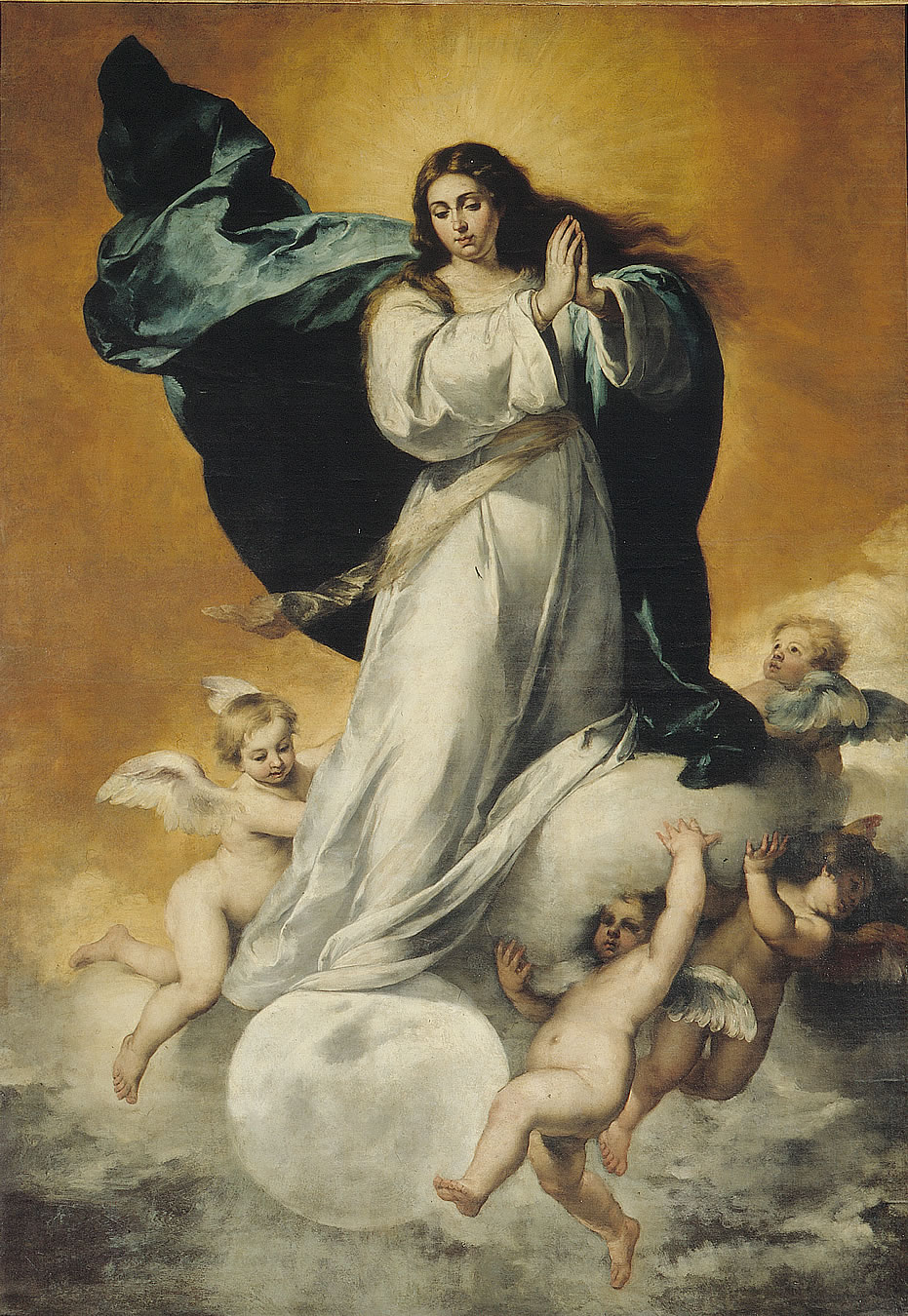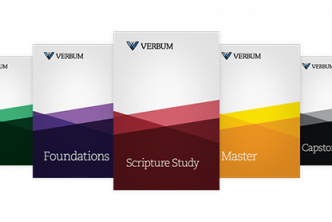 Today’s guest post is by Brandon Rappuhn, a Logos marketing copywriter.
Today’s guest post is by Brandon Rappuhn, a Logos marketing copywriter.
In one of the Catholic Church’s most controversial articles of faith, we find a historically divisive and much-debated dogma that Catholics nonetheless celebrate joyfully.
But what is the Immaculate Conception, and where does the evidence come from to substantiate this belief? Join me as I dive into the historical teaching of the Immaculate Conception using the Verbum Master package.
Hail Mary, Full of Grace; the Lord is with Thee!
The Immaculate Conception is the doctrine that Mary was born completely without original sin. The Catholic Church teaches that she still had the capacity to choose sin in her life, just as Eve did, but Catholics teach that Mary was sinless throughout her life. How do we know this? Let’s delve into the history of the teachings of the Catholic Church. Naturally, I find a good place to start in my favorite Vatican II treatise:
The Father of mercies willed that the incarnation should be preceded by the acceptance of her who was predestined to be the mother of His Son, so that just as a woman contributed to death, so also a woman should contribute to life. That is true in outstanding fashion of the mother of Jesus, who gave to the world Him who is Life itself and who renews all things, and who was enriched by God with the gifts which befit such a role. It is no wonder therefore that the usage prevailed among the Fathers whereby they called the mother of God entirely holy and free from all stain of sin, as though fashioned by the Holy Spirit and formed as a new creature. (LG 56)
But what precisely does the Catholic Church teach about the contraction of original sin and the cleansing of God? How can Mary, the daughter of a father and mother who both had original sin, be herself born without original sin? To answer this, we have to dig further back into the “Fathers” whom Pope John Paul II spoke of.
St. John of Damascus of the seventh century wrote on the holiness of Mary, as did St. Augustine of the fourth century, saying that he would not dare think to speak of her as having sin and that the Blessed Virgin Mary alone of all human beings was sinless (and this from St. Augustine, who wrote endlessly on the subject of sin). Further still, Dionysius the Great of Alexandria, in roughly AD 250, had this to say: “Christ did not live in a servile tent, but in His holy ark . . . and He preserved His mother as one who was blessed from head to foot, undefiled, even as He alone knew the manner of her conception and birth.” Thus the Catholic Church teaches that Mary, though sinless, still needed Christ for her salvation.
Controversy in the Middle Ages
While throughout history, Catholics have always believed that Mary was without sin, the nature of her sinlessness has often been a point of debate. The Middle Ages saw some interesting conversation on the Immaculate Conception—as to whether she was conceived without original sin, or conceived with original sin and subsequently cleansed of that sin before birth. (If you’re curious, the Church teaches the former.) Thomas Aquinas wrestled with this frequently and often in his writings—so much, in fact, that scholars have a difficult time determining which he actually believed. See for yourself this conversation within Thomas Aquinas’ Summa Theologica:
But the Blessed Virgin did indeed contract original sin, but was cleansed therefrom before her birth from the womb. This is what is signified (Job 3:9) where it is written of the night of original sin: Let it expect light—i.e., Christ—and not see it—(because no defiled thing cometh into her, as is written Wisd. 7:25), nor the rising of the dawning of the day, that is of the Blessed Virgin, who in her birth was immune from original sin. (ST III q.27 a.2 ad.2)
I won’t go into too much detail on this issue, but if you’re interested to do further reading, you’ll enjoy reading Mariology: A Dogmatic Treatise on the Blessed Virgin Mary, Mother of God and the article on “The Conception of the Blessed Virgin Mary” in The Lives of the Fathers, Martyrs, and Other Principal Saints. (Surprisingly, A Catholic Dictionary also has a good article on this controversy from the Middle Ages.)
The article of faith
Centuries of teaching of the Immaculate Conception led to Pope Pius IX’s formal pronouncement of the dogma in 1854. Time and time again, confusion on the subject of the Immaculate Conception has required councils, meetings, encyclicals, and books that clarify and explore the theology of the matter. Pope Pius IX himself wrote several encyclicals (See especially Ubi Primum from 1849) before writing Ineffabilis Deus, where he pronounced the dogma an article of faith.
Today we celebrate Mary’s Immaculate Conception, that without sin she would say, “let it be done unto me according to thy will” and bring forth a Savior for all mankind, undoing Eve’s decision. Let us with gratitude seek our Savior this Advent as we learn more and more about the Faith, meditate on the Word, and strive for Christ’s peace.






Perhaps, as a Catholic, I am being too sensitive, but your article is a bit misleading and lends confusion to the “divisive and much debated” discussion of the Immaculate Conception. Since clarity and understanding are critical in discussions of faith and belief, here are three statements that I think could have been clarified or stated better:
• Your first sentence is “In one of the Catholic Church’s most controversial articles of faith, we find a historically divisive and much-debated dogma that Catholics nonetheless celebrate joyfully.” One implication is that Catholics, ‘regardless of the facts,’ continue to celebrate a false doctrine.
A clearer and less divisive expression of the thought would have been: “The Immaculate Conception is one of the Catholic Church’s most cherished articles of faith, and Catholics joyfully celebrate it. Since the 16th century, however, it has grown to become a divisive and much-debated belief.”
As you cite later, the Immaculate Conception has been believed, even though there have been struggles to understand it, from the beginnings of Christianity. Partly in response to the controversy, Pope Pius IX formalized that long-held doctrine into a dogmatic statement.
• In your third paragraph, you state, “The Immaculate Conception is the doctrine that Mary was born completely without original sin.” This is true, as far as it goes, but, not going farther, it is incomplete, imprecise, and, therefore, misleading. Later, you write, “If you’re curious, the Church teaches the former” [that Mary was sinless at conception]. This further confuses the issue.
The doctrine of the Immaculate Conception is that Mary was conceived without Original Sin (of course, she would have, therefore, been born without Original Sin). Dogmatic beliefs must be stated with precision and care. It is irrelevant whether one believes the dogma. What is relevant is the accurate statement of the belief. Only from precise and common understanding can candid discussion progress.
• In your ninth paragraph, you write, “Surprisingly, A Catholic Dictionary also has a good article on this controversy from the Middle Ages.” Why is that surprising?
I hope this aids clarity.
You’re absolutely right, Phil.
On your first point, I did indeed struggle with the phrasing of that statement, but did not mean to imply that we celebrate a false doctrine. Rather, I intended to diplomatically nod to the severe schism between Protestant and Catholic articles of faith regarding Mary, especially her immaculateness. Yet even within Catholicism throughout the centuries, the fine details of Mary’s nature have been debated; yet we Catholics have always maintained, since the very beginning, that Mary was immaculate.
On your second point, you’ve hit the hammer on the nail in bringing clarity where I could not. 🙂
Finally, I found it surprising that a dictionary entry on “Immaculate Conception” would run 4+ pages in length, explore historical, theological, and Scriptural perspectives, and provide bibliographic documentation along the way. “A Catholic Dictionary” is an quite an understatement–a remarkably humble title for this resource written over a century ago.
I think it would be helpful to have a video showing us how the research was done for this article.
I put in “immaculate conception” in topic search and comes up with next to nothing.
We do not intend to create a video, but I have gone back and added logos links to all the resource citations so you can dive into the source documents. The topic guide, as Louis noted in his post about it, is being continually improved. Thank you for noting that it needs improvement on this topic, in particular.
Brandon tells me he simply ran a basic search on “Immaculate Conception” to uncover most of what he shared in this post. He said,
“There were some real gems in there that had tons of cross-references that helped me find things that didn’t come up in my search results.
“A Catholic Dictionary” and “Mariology: A Dogmatic Treatise on the Blessed Virgin Mary, Mother of God” were fantastic resources with tons of links and cross-references that connected me to tons of other resources and kept my research moving.”
Hope that helps! God bless!
This is very helpful, thank you.
I was looking up the doctrine of limbo this week and found A Catholic Dictionary by Addis and Arnold to be a great resource, surprisingly. It was very detailed and specifically in the areas of doctrinal development through the centuries. I thought I discovered a new Oxford Dictionary of the Christian Church!
Anyway, thanks for the post. Happy Solemnity of the Immaculate Conception!
Alex, you have summarized in the length of a single post, and with clearness, the main points of this dogma, often not perfectly understood even by catholics. Well done, God bless you!
Thank you for the praise, but credit is due to Brandon Rappuhn, the author of the post. I merely put it online.
Happy Advent!